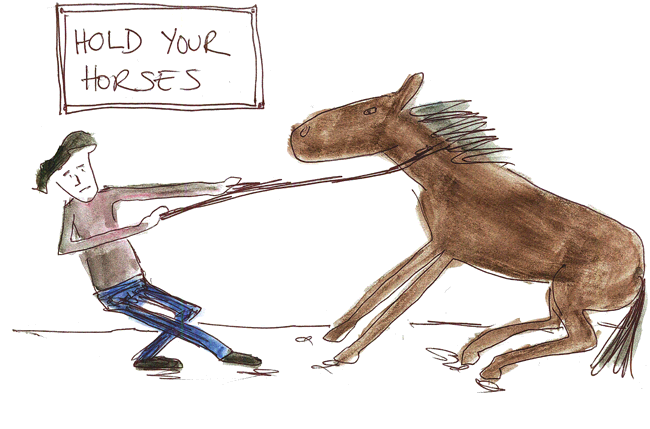
When sharing experiences with one another it is easy to believe we are communicating in literal terms. Closer examination reveals that most communication is abstracted into metaphor. Our life is shared with others through both subtle and colorful abstractions.
I’ve been exploring, studying, and training in transformational modalities for nearly two decades. Figures such as Virginia Satir, Dr. Milton Erickson, John Grinder, Richard Bandler, Steve and Connirae Andreas, Robert Dilts, Tad James and many others seemed to share a foundational concept in their practices – accepting their clients’ view of the world very literally.
To make changes, first we have to realize that we are talking in stories, not in facts. To get to a place where changes can take place, we must listen to words at face value. This approach is echoed in Zen stories putting an emphasis on “what is,” coaching and therapeutic models such as Clean Language, and on the stage in Improvisational Theater as well.
Real, Imaginary, Beliefs, and “Truth”
One key difference between what is “real” and what is “imaginary” is our level of belief. When performing with improvisers the very first rule is to “accept offers.” An offer is when a fellow performer makes a statement or does a pantomime that implies an activity, another performer responds by accepting that “offer,” creating a meaning for that offer, and expanding on it to co-create a story.
This expansion is powered by a rule of saying “yes, and” to provide the thrust that keeps a scene engaging for an audience. All offers are metaphorical in that they are not what is actually happening in real life (where we are literally in the act of performing), we are embodying characters involved in concepts and ideas upon which the performers keep adding layers of meaning. We treat the imaginary as real because we are on stage and have agreed to pretend together. However, there is almost no difference between stories created in the context of Improv and incidents that happen in our day-to-day lives that we believe to be truth.
The true power in coaching is being able to recognize when metaphor reveals the contour of belief and then co-exploring the deeper meaning of what is being said (or often, what is not said).
When working with clients I listen carefully to what they share. There is information, of course, but also concepts, ideas, and gateways to underlying beliefs about themselves, the people they interact with, and the world at large. The true power in coaching is being able to recognize when metaphor reveals the contour of belief and then co-exploring the deeper meaning of what is being said (or often, what is not said). Most of us are unaware that we are generating the meaning of our own lives through metaphorical language, and if we change our underlying metaphors, we consequently change the meaning of our lives.
The Empowering Nature of Metaphor
Metaphors act as catalysts for transformation. When clients share a metaphor, they’re outlining a landscape where they have the power to move mountains or chart new territory (<- metaphor alert!).
Consider the classic image of “being at a crossroads,” the language eeds the notion that paths can be selected, explored, and walked with intention. When we treat these stories with respect and curiosity, we help unlock a client’s sense of possibility. Suddenly, stuckness becomes decision; overwhelm transforms into the first step taken.
By working within the metaphoric framework a client brings, we help them notice resources they already possess; a rehearsal for real-world change, and in that rehearsal, clients often discover strengths and solutions hidden in plain sight.
Which leads me to being literal about metaphors
Credulousness is my word for a specific coaching mindset that takes a client’s metaphor entirely as shared and treating it with unshakable positive regard. From this point we can now connect at a deep level of communication and shared understanding. The more we explore the shared metaphor the more we increase the richness and depth of our communication, setting the stage for making a desired life change.
Imagine a client has an overdue report and her co-workers are waiting on its delivery because there is something in it that will drive decisions going forward. It can be tempting to coach her on “time management skills,” “workplace responsibilities” or listen as she beats herself up with self-judgment like feeling guilty. However, the actual level where attitudes are transformed occurs when we discuss metaphors with Credulousness.
What Makes a Metaphor Work in Coaching?
So, what metaphors truly spark change in a coaching session? It’s about meeting the client where they are, using language that matches what they are representing in symbols and representations beyond surface language.
Here are some hallmarks of a transformative metaphor in coaching:
- A powerful coaching metaphor feels tailor-made for the client–it captures their circumstances in a way that’s both recognizable and fresh. Whether their challenge feels like “climbing Everest” or “navigating New York City traffic,” the metaphor should make their internal landscape visible.
- The most effective metaphors distill a situation down to its essence, allowing both coach and client to cut through confusion and focus on what matters most.
- The right metaphor paints vivid mental pictures and invites an emotional response—sometimes a laugh, sometimes a sigh of recognition—that nudges the client closer to insight.
- The aim is to spark possibility. Metaphors that highlight the client’s agency by reframing “trapped in a maze,” as “exploring uncharted territory.”
- A good metaphor honors the client’s background and values. It connects through shared symbols.
- The conversation is richer when the metaphor flexes as the coaching session unfolds. “Let’s spin the globe and pick a new destination” maintains the ideas set out in “exploring.”
When Late Work Turns Spoooooky!
It’s nearly Halloween, which means we have the supernatural on our minds. In a coaching conversation, our client shares something like, “I feel haunted by deadlines. They intimidate me.” Notice that metaphor? Does it feel familiar to you in some way?
With an attitude of Credulousness we move beneath the surface level of the statement (which seems to be about deadlines) and instead explore the metaphor of “haunted.”

Since when are missed deadlines the same as ghosts? Time to get credulous and literal about metaphors!
The interaction might go something like this:
Client: “I feel haunted by deadlines, they intimidate me.”
Coach: “Haunted like what?”
Client: “Like a ghost. You know, like a ghost hovering over my head.”
It is important to resist the urge to mix in our own metaphors while exploring the client’s. I could point out that it is common to say “this deadline is looming,” but that is adding my own ideas to hers. It is her story to tell. It is much like Improv, only taking place inside the client between her conscious and her sub-conscious concepts.
Now back to being Credulous:
Coach: “And whereabouts over your head?”
Client: (pointing up and over their right shoulder) “Right over here.”
Credulousness means you believe her statement: there is a ghost hovering over her right shoulder. Your role is not to debunk, discount, or reframe that concept. She shared this metaphor while co-creating in our coaching conversation. In respecting the metaphor as “real,” we increase the depth of the conversation and widen the connection for the client between the literal and the symbolic actions taking place in her life.
Depending on your experience and training there are many possible ways to interact with stories and metaphors. In my training with Dr. Richard Bandler in Neuro-Linguistics we discuss working at the level of client metaphor with an eye on “playing with it” and discovering how making changes in details can alter meaning.
In this story, the client has made “an offer” that the deadline is the same as a ghost that hovers over her right shoulder. We are going to ask lots of questions to help make that metaphor as rich as possible.
What about the deadline?
It is tempting to ask, “Why aren’t you addressing the missed deadlines? What do ghosts have to do with anything? They aren’t even real.” However, consider how often advice on how to “do a better job” or “caring more about deadlines” are empty instructions that are really about treating the surface issue. We can be assured that our client had conversations with her bosses about performance already. To deal with deadlines, we are going to have to discuss ghosts.
Let’s get credulous and explore a world where missed deadlines and ghost hauntings are the same!
Let’s roll back a bit and rejoin our client conversation:
Coach: “And whereabouts over your head?”
Client: (pointing up and over their right shoulder) “Right over here.”
Coach: (gesturing to that location) Right there. Got it. Anything else about those ghosts?”
Client: Yes, it is like they are pressing down on my shoulders.
Coach: Can we play around a little bit? (The client gives me her permission) May I move this around (gesturing to the vicinity of the location of the ghosts)?
There are many questions we could ask about “feeling haunted by ghosts over the client’s right shoulder that feel like they are pressing down on her shoulders.” In this example, I chose to discover with the client what happens when we move the ghosts around. How did I know I could do that? I asked the client. If she says “No” then we just move to another set of questions related to the metaphor she shared.
Coach: (Reaches back, mimes getting a really good grip on the ghosts and pulls that imaginary sphere so it is right in the main visual field of the client.)
Client: (Eyes get wide) Whoa! I understand it now! The deadline is still in front of me until I am done – I need to finish this now! (Shakes shoulders) I feel so much lighter!
Coach: How about the deadlines? Still haunted?
Client: No! I have just been being silly. I was afraid for no reason and wasn’t doing my work. Now that it is right in front of me, I can see it for what it is.
Our minds are very imaginative and create stories and meanings around our events. There are times when it makes sense to have direct conversations about work performance and times where a different approach is needed to get the most from employees. In my view, having a staff member lose their job because “they don’t listen” is a shame, and can be avoided by actually listening credulously.
Now you try!
It’s time to turn on your metaphor-o-meter! In the next five conversations you have with others really listen for their use of metaphor, especially metaphors of location – that is where the other person uses a preposition like “under the gun,” “over the moon,” “in the soup.”
Just notice.
Then start noticing yourself.
We all use metaphors – our brains are wired that way. Learning how you describe your own experiences in new metaphors is a path to doing new things in your own life.
